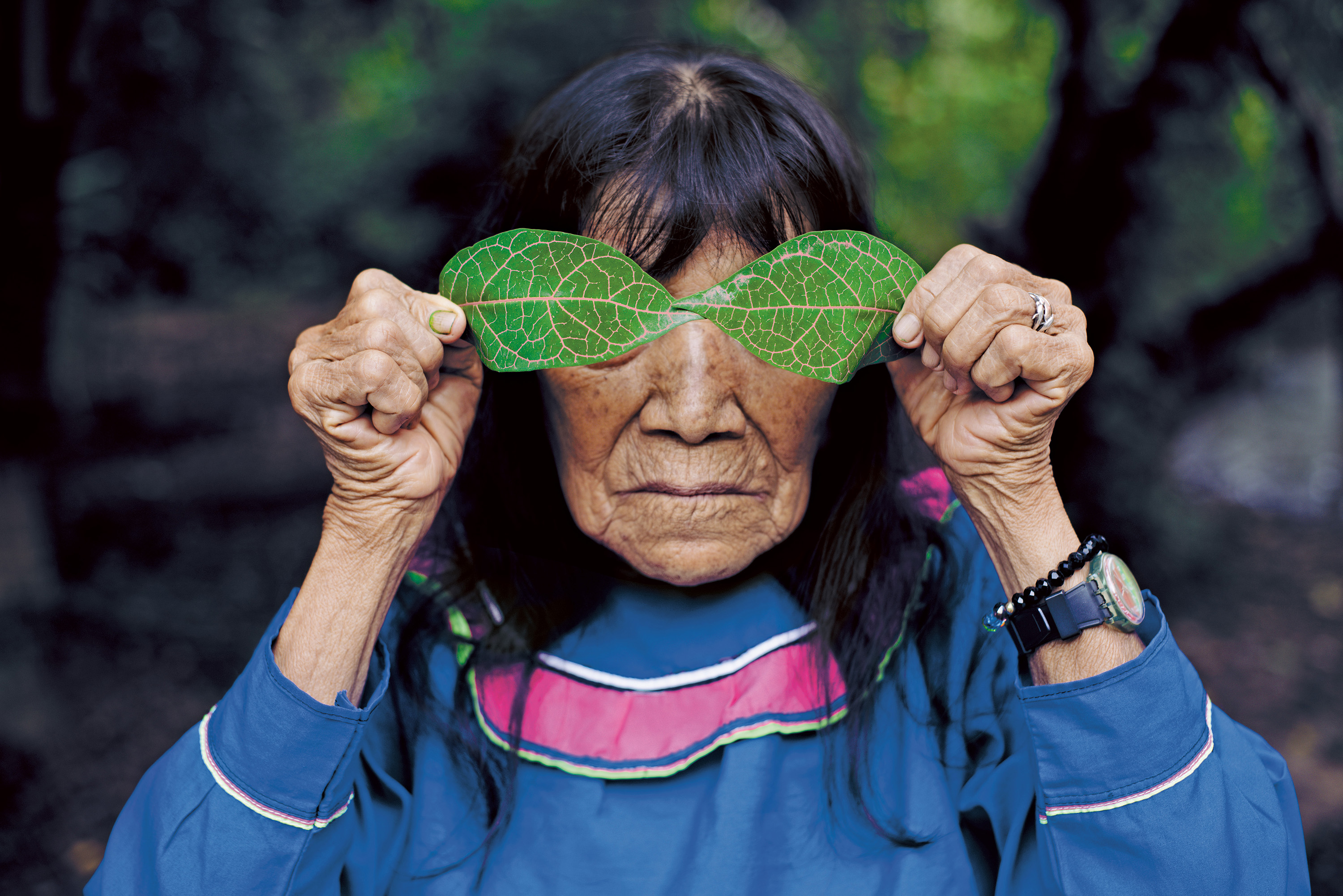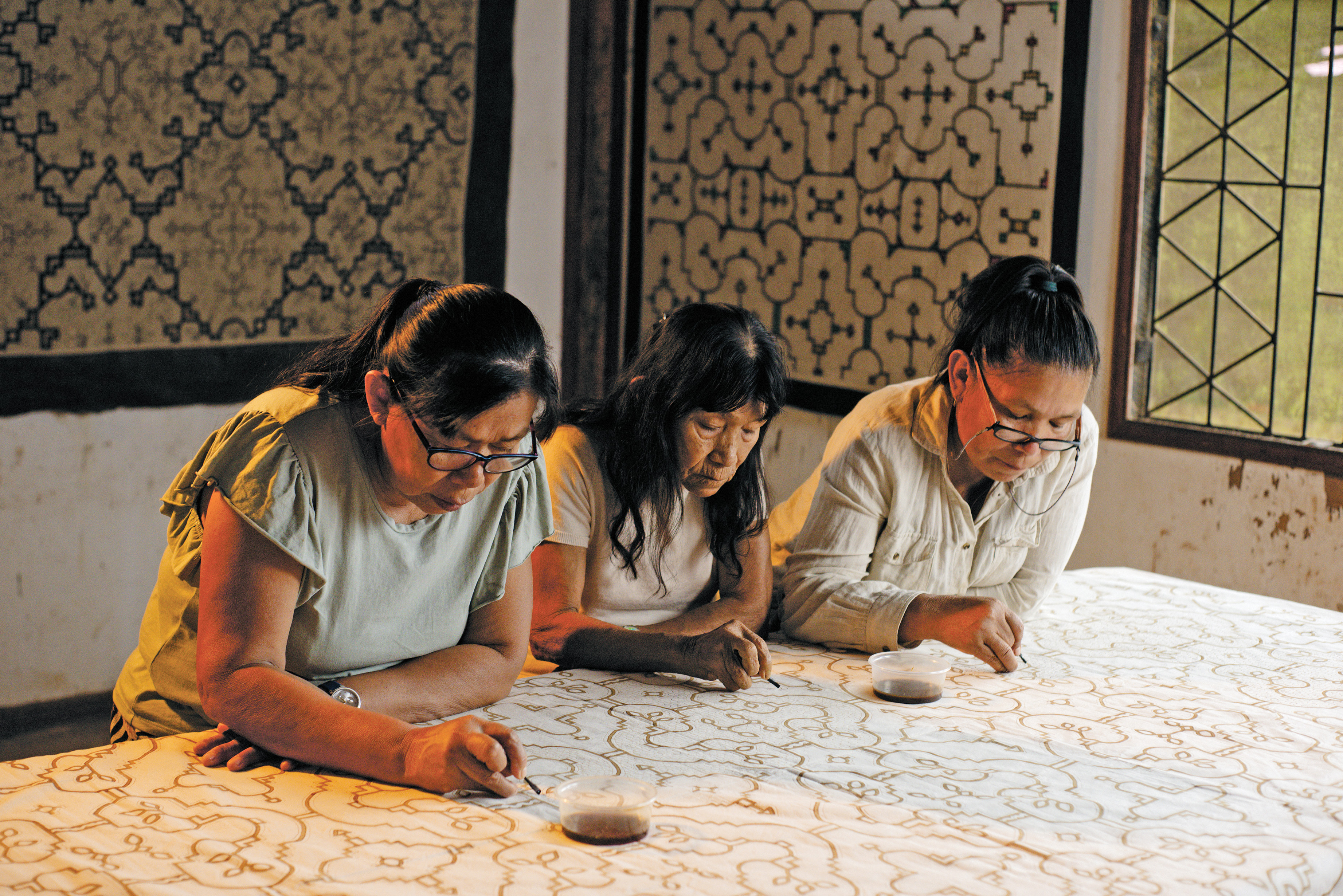Latin America
Related: About this forumThe Amazon Has Been This Peruvian Artist's Home, Inspiration and Palette. Now the World Is Her Gallery
The art of making captivating Peruvian textiles has traditionally been anonymous work. But at 75, Sara Flores is making a name for herself with hypnotic abstractions
Opener
Flores holds up leaves from the Fittonia albivenis,a rainforest plant whose veins naturally form the patterns her people call kené.
Prin Rodriguez
By Jay Cheshes
Photographs by Prin Rodriguez
November 2025

Flores holds up leaves from the Fittonia albivenis,a rainforest plant whose veins naturally form the patterns her people call kené.
Prin Rodriguez
Sara Flores sat against the wall, flanked by family, in a traditional Shipibo-Conibo wrap skirt and blouse. She was attending the opening, this past spring, of her solo show “Sara Flores. Non Nete. A Dream for an Indigenous Nation,” and she was overwhelmed with attention, swarmed by well-wishers. The exhibition was the first devoted to a contemporary Indigenous artist in the 64-year history of the Lima Art Museum, one of Peru’s premier cultural institutions. The museum’s permanent collection, spanning 3,000 years, includes Inca treasures and Spanish colonial masterworks but virtually nothing at all from the Amazon region where Flores, a member of the Shipibo-Conibo community, lives and works. Now Flores’ hypnotic abstractions covered the gallery’s walls: geometric labyrinths meticulously painted on stretched cotton fabric using natural pigments she makes from plants she gathers from the rainforest. Some of the interlocking patterns were monochrome, others a riot of color, the optical effect almost electric.
Before Flores entered her 60s, her name was almost entirely unknown outside her own community. Her work is steeped in the ancient Shipibo-Conibo tradition of patternmaking known as kené. The art form is communal and typically anonymous. Historically, few practitioners signed their work. Kené’s unwritten rules and precise, symmetrical visual language have been passed down for generations along matrilineal lines. Most Shipibo-Conibo art was long dismissed as folkloric by the cultural establishment. But in 2011, an Italian-born artist named Matteo Norzi came across Flores’ work at a handicrafts shop in Peru, and, after years of trying to find her, he finally tracked her down in the jungle. He helped her secure her first public presentation, in a 2018 group show with international artists in New York. “That was a really important moment, because the work had really not been shown by anyone,” Brett Littman, the show’s curator, told me recently. “And it was really good for Sara, and it opened up her work to a lot of contemporary artists and curators.”
Key Takeaways: What is kené?

Flores and daughters
Flores paints with her daughters, 53-year-old Deysi Ramírez (left) and 58-year-old Pilar Ramírez (right). The Shipibo-Conibo people traditionally pass down the art of kené from mother to daughter. Prin Rodriguez
Flores’ profile soared after that: Her work was shown in Paris, Miami, Madrid and Hong Kong. Earlier this year, the Guggenheim Museum in New York acquired one of her pieces. The London gallery White Cube signed her in 2023 and began planning a big exhibition. Flores’ lack of recognition in her own country began to seem like a glaring omission. “There has been a lot of buzz around the work of Sara lately,” said Sharon Lerner, the director of the Lima Art Museum. “But she had never shown in a museum in Peru.”
At the opening, John Alfredo Davis, an authority on Peruvian painting and textiles and a longtime champion of Shipibo-Conibo art, told me that he’d approached the museum about hosting a Shipibo-Conibo exhibition more than 20 years earlier. “They told us, ‘Folk art is not coming to this museum, ever,’” he recalled. But since that time, curators and collectors all over the world have sought to expand the definition of fine art. Indigenous art was a major focus at the last Venice Art Biennale, in 2024.
More:
https://www.smithsonianmag.com/arts-culture/amazon-peruvian-artists-home-inspiration-palette-world-gallery-180987459/
~ ~ ~
When you get some time, you might enjoy comparing the imagery appearing in the architecture of an indigenous man, Freddy Mamami, in the neighboring country, Bolivia, in El Alto, near La Paz, on the mountain tops, in arrid, colder environs. It takes a while to notice, maybe, but there are some similarities.
Here's the link to many image photographs and their sources at Google images:
https://tinyurl.com/3bxunxtx
Easterncedar
(5,118 posts)There’s so much to the story of the artist’s life, the early development of her art and its late discovery by people willing to help rather than exploit her. Beautiful.